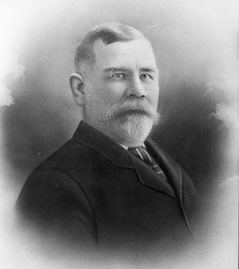Name John Brady Religion Presbyterian | Political party Republican Role American Politician | |
 | ||
Born May 25, 1847New York City ( 1847-05-25 ) Spouse Elizabeth Patton (m. 1887) | ||
John (James) Green Brady (May 25, 1847 – December 17, 1918) was an American politician who was the Governor of the District of Alaska from 1897 to 1906, when he was forced to resign due to his alleged involvement with the fraudulent Reynolds–Alaska Development Company. Brady was later exonerated.
Contents
Childhood in New York City
John Green Brady was born in New York City. Upon the death of his mother, his father re-married. Brady did not get along well with his step-mother, and at the age of eight ran away from home to avoid beatings from his drunken father. He was found living on the streets of New York City by Theodore Roosevelt, Sr. a well-known and popular New York City philanthropist and the father of future US 26th President, Theodore Roosevelt. Many years later, as an adult, Brady would approach the younger Theodore Roosevelt then governor of New York, in 1900, at a conference in Portland, Oregon, warmly shake his hand and tell him the following story:
"Governor Roosevelt, the other governors have greeted you with interest, simply as a fellow governor and a great American. but I greet you with infinitely more interest, as the son of your father, the first Theodore Roosevelt." When greeted warmly by Governor Roosevelt and asked why and in what special way he had been interested in his father, Governor Brady replied, "Your father picked me up on the streets of New York, a waif and an orphan, and sent me to a Western family, paying for my transportation and early care. Years passed and I was able to repay the money which had given me my start in life, but I can never repay what he did for me, for it was through that early care and by giving me such a foster mother and father that I gradually rose in the world until I greet his son as a fellow governor of a part of our great country."Brady was at the House of Refuge on Randall's Island when he learned about the Orphan Train. The eleven-year-old Brady declared himself to be an orphan and, on August 2, 1859, boarded a train bound for Indiana. Over the course of the week-long journey Brady forged what would be a lifelong friendship with Andrew Burke, another boy his age from Randall’s. The boys got off the train at Noblesville, Indiana where they were taken to “Aunt” Jenny Fergusson’s hotel, fed and, in turn, put on display for prospective adopters.
Brady went to live with the family of John Green, of Tipton County, Indiana. Judge John Green recalled, “I decided to take John Brady home with me because I considered him the homeliest, toughest, most unpromising boy in the whole lot. I had a curious desire to see what could be made of such a specimen of humanity.” He attended Yale University and graduated in 1874.
Brady married Elizabeth Jane Patton in 1887 in Sitka, Alaska. Children: John Green Brady Jr., Hugh P. Brady, Sheldon Jackson Brady, Mary Anna Brady and Elizabeth P. Brady.
District of Alaska
Brady moved to Alaska Territory first as a Presbyterian minister, missionary, lawyer and co-founded what is now Sheldon Jackson College as a school for training Alaska Natives in 1878. Later he would be appointed Governor for three terms. He was introduced to the infamous Alaskan bad man Soapy Smith during the July 4, 1898 festivities in Skagway. Brady was made aware of Soapy's criminal activities and offered him a position as a deputy U.S. marshal in Sitka if he would quit Skagway. Soapy turned down the position and Brady noted it in a personal letter. Four days after meeting him, Soapy was killed in the famed Shootout on Juneau Wharf.
Governor Brady had an interest in preserving the culture of the Alaska natives. He orchestrated the placement of 15 Haida and Tlingit totem poles and two traditional houses for the 1904 Louisiana Purchase Exposition.
He was instrumental in the preservation and relocataion of the totem poles from Old Kasaan village to Sitka shortly after Old Kasaan's abandonment.Brady died on December 17, 1918 and was buried in Sitka National Cemetery in Sitka, Alaska. He was interred in Section R, Plot 4 in December 1918. The monument at his grave bears the inscription: "A life ruled by faith in God and Man."
